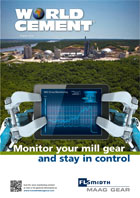Editorial comment
Those active on Twitter may have noticed the hashtag #Apollo45 trending recently, as Buzz Aldrin encouraged people to take to social media to share what they were doing on 20 July 1969, when humans took their first steps on the moon. The campaign marks the 45th anniversary of the Apollo 11 moon landing – an iconic moment that now serves as a reminder of how far technology has advanced over the last half century. Reflecting on fellow astronaut Neil Armstrong’s famous phrase, Aldrin notes: “Imagine the great magnificence of humanity going from horse and buggy, to railroads, cars, and airplanes, to rockets – and now walking on the moon. That is a testimonial to the progress of the creatures here on Earth.”*
Register for free »
Get started now for absolutely FREE, no credit card required.
Last year, World Cement interviewed FLSmidth MAAG Gear’s CEO, Simon Jensen, on the occasion of the company’s 100th anniversary. When asked what he hoped the company would achieve in the future, Jensen told us: “I would love it if MAAG could supply the first drive unit to FLSmidth on the Moon or on Mars. That’s ambition, right?” (World Cement, April 2013). It is perhaps an ambition that is gradually moving closer to reality. NASA has set its sights on Mars, announcing that ‘the first humans who will step foot on Mars are walking the Earth today’.
Yet NASA’s activities are focused down towards the Earth as much as they are skyward. On 2 July 2014, NASA launched the Orbiting Carbon Observatory-2 (OCO-2), its first spacecraft dedicated to studying atmospheric carbon dioxide. The observatory will collect data on the natural sources of carbon dioxide and ‘sinks’ – the areas on the planet’s surface where CO2 is removed from the atmosphere. It is hoped that the mission will provide greater insight into how the Earth adjusts to higher carbon dioxide production levels.
Back on firm soil, the cement industry is doing its own bit to reduce emissions levels and enhance sustainability. Some of the sector’s approaches to limiting its environmental impact are outlined in this issue. On pages 55 – 68, for example, you can read more about alternative fuel use – from the technical developments that allow for its safe and efficient handling to quality management. Meanwhile, over on page 94, Tim Kuebler explains how advocacy can alter misconceptions about the industry and help to promote concrete as a sustainable solution.
For more on the actions that the cement industry is taking to lower its environmental footprint (whether it be a ‘small step’ or a ‘giant leap’), check out the ‘Environmental News’ section on www.worldcement.com. Whilst there, you can also watch a clip of the OCO-2’s launch from the Vandenberg Air Force Base in California in a Delta II rocket – simply search ‘Lift off!’.
*http://edition.cnn.com/2014/07/15/opinion/aldrin-my-moon-walk-mars


